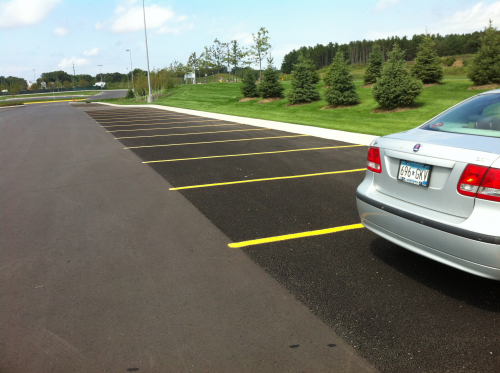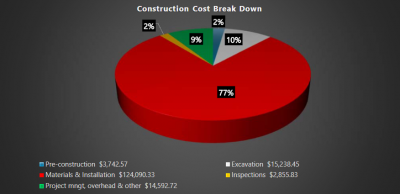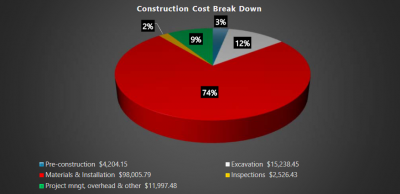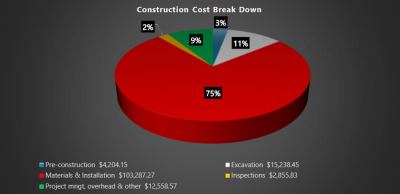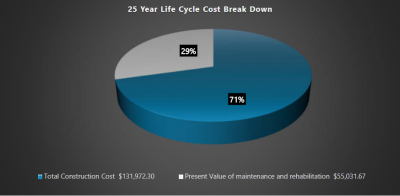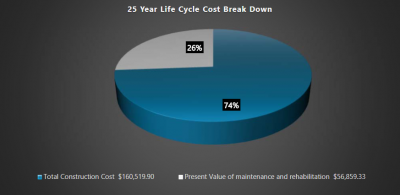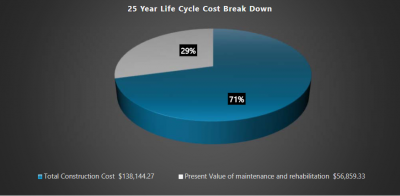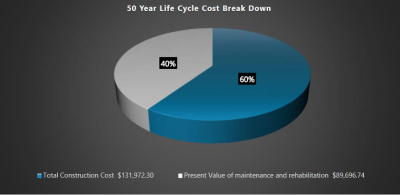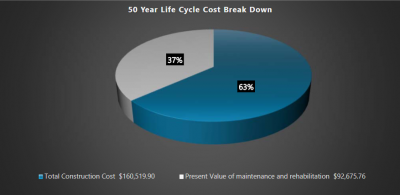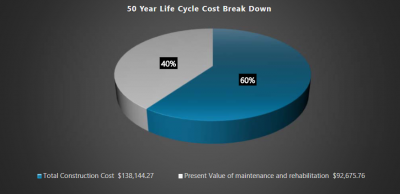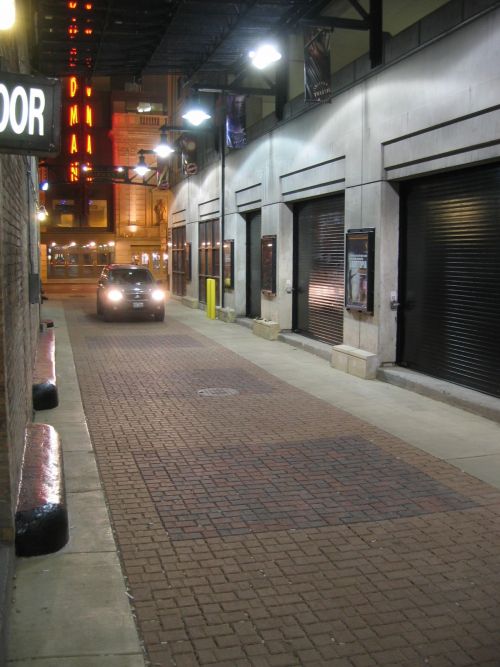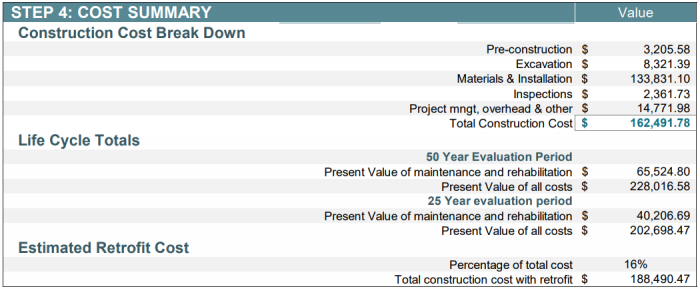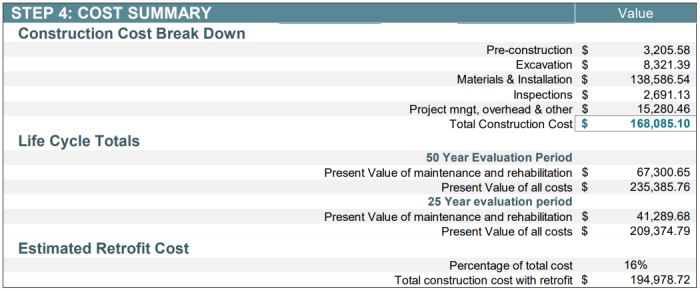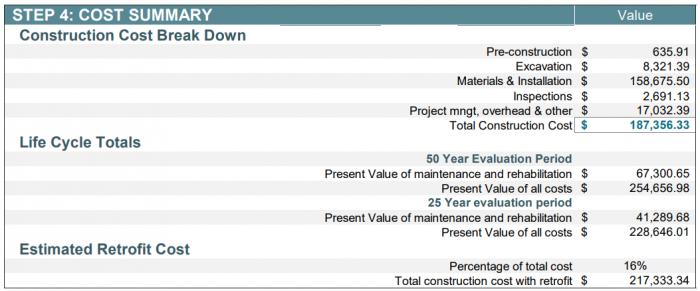Difference between revisions of "Porous Asphalt: Life Cycle Costs"
| Line 62: | Line 62: | ||
==Life Cycle Costs== | ==Life Cycle Costs== | ||
Below are both the capital and life cycle costs of the three [[permeable pavements|porous asphalt]] configurations over a 25- and 50-year time horizon based on a detailed assessment of local input costs, maintenance requirements, rehabilitation costs and design scenarios relevant to Canadian climates. The costs of maintenance and rehabilitation (Life cycle costs) are set at "Present Value" of these activities in 2022. The estimates of maintenance and rehabilitation (life cycle) costs represent net present values (NPV). Operation and maintenance costs are predicted to represent between | Below are both the capital and life cycle costs of the three [[permeable pavements|porous asphalt]] configurations over a 25- and 50-year time horizon based on a detailed assessment of local input costs, maintenance requirements, rehabilitation costs and design scenarios relevant to Canadian climates. The costs of maintenance and rehabilitation (Life cycle costs) are set at "Present Value" of these activities in 2022. The estimates of maintenance and rehabilitation (life cycle) costs represent net present values (NPV). Operation and maintenance costs are predicted to represent between 26 to 29% of total life cycle costs over the 25-year evaluation period, and increase to between 36 to 29% of total life cycle costs over the 50-year period, due to costs associated with increased surface vacuuming, replacement of joint material after vacuuming, restriping, replacement of pavers and cleaning out underground pipes (underdrain and overflow) to prevent [[clogging]] assumed to be continually required after 25 years of operation. | ||
===25-Year life cycle cost break down=== | ===25-Year life cycle cost break down=== | ||
Revision as of 16:18, 19 December 2022
Overview[edit]
Porous Asphalt is an alternative to traditional impervious pavements that allow stormwater to drain through them and into a storage reservoir below. Porous asphalt's performance and integrity is similar to that of other standard asphalt pavements. Porous asphalt contains air pockets, which are created during the development process of the paver due to the inclusion of less fines and sand content in comparison to traditional asphalt. The "air pcokets" or greater void spaces are what allow stormwater to infiltrate through the surface level to the underlying stone aggregate layer bed[1]. The benefit of porous asphalt in comparison to some other permeable pavements is that it doesn't require third party, proprietary components, nor specialized paving equipment for installation[2].
Depending on the native soil properties and site constraints, the system may be designed for full infiltration, partial infiltration, or as a non-infiltrating detention and filtration only practice. They can be used for low traffic roads, parking, driveways, and walk ways, and are ideal where space for other surface BMPs is limited. Permeable pavement types include:
- permeable interlocking pavers (concrete or composite materials)
- grid systems (concrete or composite materials)
- pervious concrete (poured-in-place or pre-cast)
- porous asphalt
- permeable articulating block/mat systems
For the sake of this page and associated costs/figures below the information found here relate to Porous Asphalt, for costs and information associated with Permeable pavements click here. STEP conducted life cycle costs estimates for each of permeable pavements 3 design configurations which can be viewed below. To design your own life cycle cost estimates that can be adapted to fit your project budget and unique development needs access the updated LCCT Tool here.
Design Guidance[edit]
Permeable pavers are ideal for sites with limited space and projects such as low traffic roads, parking lots, driveways and walkways. Components include: interlocking pavers, precast pervious slabs, cast in place surface, bedding course, and underground storage layer. Additional components include an underdrain to remove excess water and soil additives to enhance pollutant removal.
Design Assumptions[edit]
Porous asphalt is ideal for sites with limited space and projects such as low traffic roads, parking lots, driveways and walkways. Components include: a porous asphalt surface, a stabilizer course, and a base layer for storage. Additional components include an underdrain to remove excess water and surface drains to deal with runoff flows in excess of design capacity.
Design and operation and maintenance program assumptions used to generate cost estimates are based on tool default values and the following STEP recommendations:
- Native soil infiltration rates for Full, Partial and No Infiltration Design scenarios were assumed to be 20 mm/h, 10 mm/h and 2 mm/h, respectively, and a safety factor of 2.5 was applied to calculate the design infiltration rate.
- Operation and maintenance (O&M) cost estimates assume annual inspections, removal of trash and debris twice a year, and vacuum sweeping annually. Verification inspections are included every 5 years to confirm adequate maintenance, and every 15 years to confirm adequate drainage performance through in-situ surface infiltration rate testing.
- Impervious drainage area to permeable surface area (I:P area) ratio of 1:1
- Default Stabilizing course/ Choker layer (19 mm dia. clear stone) depth of 50 millimetres.
- Default Asphalt depth of 110 millimetres.
- Default Stone resevoir (50 mm dia. clear stone) depth of 230 millimetres.
- A 150 mm diameter perforated underdrain pipe is included in Partial Infiltration and No Infiltration design configurations only.
Notes[edit]
- Operation and maintenance cost estimates include removal of sediment from the catchbasin, by annual surface vacuum sweeping, repairing of potholes and assume no rehabilitation of the porous asphalt surface is required over the 50 year timeframe.
- The tool calculates costs for new (greenfield) development contexts and includes costs for contractor overhead and profit, material, delivery, labour, equipment (rental, operating and operator costs), hauling and disposal.
- Land value and equipment mobilization and demobilization costs are not included, assuming BMP construction is part of overall development site construction.
- Design and Engineering cost estimates are not calculated by the tool and must be supplied by the user.
- The tool adds 10% contingency and additional overhead as default.
- All cost estimates are in Canadian dollars and represent the net present value (NPV) as the tool takes into account average annual interest and discount rates over the 25 and 50 year operating life cycle periods.
- Unit costs are based on 2018 RSMeans standard union pricing.
- Additional costs associated with retrofit or redevelopment contents is assumed to be 16% higher than the cost for new (greenfield) development contexts.
- Retrofit construction cost estimates are included in the 'Costs Summary' section for comparison.
- Retrofit construction cost estimates are included in the 'Costs Summary' section for comparison.
Construction Costs[edit]
Note: Please click on each image to enlarge to view associated construction cost results.
Above you can find a cost breakdown of a 1000m2 in three different configurations:
- Non-infiltrating/filtration only Porous Asphalt,
- Partial infiltration Porous Asphalt
- Full infiltration Porous Asphalt
As can be seen the greatest cost for this practice (regardless of configuration type) will be Material & Installation, which include costly components such as the, impermeable membrane/liner, the underdrain, the porous asphalt sub-base of 50mm clear stone, the conventional asphalt base course (stone reservoir) of 230mm Granular A, the 19mm Stabilizing course and the asphalt (both conventional and permeable).
Life Cycle Costs[edit]
Below are both the capital and life cycle costs of the three porous asphalt configurations over a 25- and 50-year time horizon based on a detailed assessment of local input costs, maintenance requirements, rehabilitation costs and design scenarios relevant to Canadian climates. The costs of maintenance and rehabilitation (Life cycle costs) are set at "Present Value" of these activities in 2022. The estimates of maintenance and rehabilitation (life cycle) costs represent net present values (NPV). Operation and maintenance costs are predicted to represent between 26 to 29% of total life cycle costs over the 25-year evaluation period, and increase to between 36 to 29% of total life cycle costs over the 50-year period, due to costs associated with increased surface vacuuming, replacement of joint material after vacuuming, restriping, replacement of pavers and cleaning out underground pipes (underdrain and overflow) to prevent clogging assumed to be continually required after 25 years of operation.
25-Year life cycle cost break down[edit]
Note: Please click on each image to enlarge to view associated life cycle cost results.
50-Year life cycle cost break down[edit]
Note: Please click on each image to enlarge to view associated life cycle cost results.
Total Cost & Design Summary[edit]
As previously discussed the three Permeable pavement configurations total cost summary vary greatly dependent on whether you want your feature to possess full infiltration, no infiltration, or partial infiltration. In short the most expensive of these options is the Permeable Pavement: No infiltration option ($187,356.33 vs. $168,085.10 - partial infiltration and $162,491.78 - full infiltration). The same can be said for construction + associated retrofit costs with each configuration design ($217,333.34 vs. $194,978.72 - partial infiltration and $188,490.47 - full infiltration). This configuration costs more than the other two predominantly due to the addition of an over 1,100m2 Impermeable membrane (0.762 mm High Density Polyethylene-HDPE), which costs $24,181.47. This difference in price accounts for all three configurations possessing the exact same surface area footprint of 1,000m2. As a reminder, it is important to understand your site's surrounding native soil infiltration rate to ensure you are selecting the appropriate design and if your site is located within a WHPA or Pollution hotspot, thus requiring a non-infiltration practice such as the aforementioned configuration of a permeable pavement feature.
A final note regarding the accuracy of the LCCT. A follow up sensitivity analysis study was conducted by CVC & STEP back in 2019 to test the tool's accuracy. The analysis took designs from 6 completed projects (4 bioretention, 1 permeable pavement, and 1 infiltration trench), and ran them through the tool comparing construction costing results from the LCCT to actual construction costs for the projects. The accuracy target set for the tool was plus-or-minus 30% of actual construction costs.
The analysis found that the tool was on average (±14%) to actual construction costs[3]
Full Infiltration[edit]
Partial Infiltration[edit]
Non-Infiltrating/filtration only[edit]
References[edit]
- ↑ City of Toronto. 2017. Toronto Green Streets Technical Guidelines. Version 1.0. August, 2017. https://www.toronto.ca/legdocs/mmis/2017/pw/bgrd/backgroundfile-107515.pdf
- ↑ Speight, J.G., 2016. Asphalt materials science and technology (pp. 437-474). Butterworth-Heinemann is. https://link.springer.com/article/10.1557/mrs.2016.267#article-info
- ↑ Credit Vally Conservation (CVC). 2019. Life-cycle costing tool 2019 update: sensitivity analysis. Credit Valley Conservation, Mississauga, Ontario. https://sustainabletechnologies.ca/app/uploads/2020/04/LCCT-Sensitivity-Analysis_March2020.pdf
